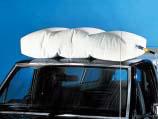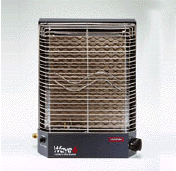|
Besides power management issues, covered extensively in other areas, effective boondocking requires potable water management,
waste management, and more effective heating than a standard RV is equipped for. These items are covered lightly here.
Water Management
When boondocking you have have a finite amount of water. One of the biggest issues is getting more fresh water. Besides
conservation methods people use many techniques to fetch fresh water, depending on how avid they are about boondocking. Long-term
boondockers usually have large (over 55 gallon) fresh water storage containers for getting water. Often, several drums. Sometimes
these are permanently built into their tow vehicles - other times they are temporarily used.

We prefer using a flexible plastic water bladder. When not in use this bladder takes up little room, yet it hold 45 gallons
of water. The picture shows this on the roof of a truck, which we have done. But with the Volvo tractor we carry it on the
bed. We have driven 5-6 miles with it on the pickup roof, though (but slowly). We generally gravity feed this into our water
tank, but if necessary we can pump it with a spare water pump for the RV. Carrying the extra water pump allows us to pump
water, and also is the backup pump for the RV, in case our primary pump breaks. We got our water bladder at Camping World,
and have been using it for years. It costs about $85, but we feel it is well worth it for the convenience.
Waste Management
Waste management falls into grey and black water. Often, grey water can be dumped on the ground, and we do not hesitate
to do this, where it is appropriate. In our opinion this causes no harm, but we leave that determination to you. We don't
do this in campgrounds or parking lots, but in dispersed boondocking situations it is an effective way to dispose of gray
water. Where we can not dump grey water we use our "blue boy" to take the grey to the dump station, along with the black water.
There are many discussions of dumping grey water on the various camping forums - with some very radical opinions on both sides
of the issue. Read them and form your own opinion, but please don't dump grey where it causes a nuisance.
Black water has to be removed to a dump site. We either pull our trailer out, or use a "blue boy", depending on the circumstances
and how far the dump site is from our location.Our blue boy is the 25 gallon model with 4 wheels. We can easily pull it behind
the truck, or by hand. We don't currently have one, but with a macerator pump you can put the blue boy in the truck bed and
pump the waste into it. This makes transport more convenient. With our current trailer we can easily go 25 days on our
black tank so black tank dumping is not a big issue.
Heating
Your furnace wastes a lot of heat, and uses a lot of 12-volt power doing it. The furnace is only about 50% efficient.
If you doubt this go outside and place your hand near the furnace vent when it is running. Using a catalytic heater or blue
flame heater is more efficient, and also uses no power. We prefer the catalytic heater, since there is no smell at all with
it. Some people are affected by the blue flame heaters, although we cannot smell them. Check it out for yourself...both work
well.

We use an Olympian Wave 6 catalytic heater with a freestanding kit. That way we can move it around
as we choose. We use this heater all winter, even if we have hookups. It puts out infrared heat and is much nicer than the
furnace. We tapped into the gas line that feeds the stove and have a 12' hose with a quick connect fitting on it (and a shutoff
valve). The furnace still needs to run a little to make sure your plumbing lines remain unfrozen in really cold weather (to
heat your storage bays). At night we set our furnace to about 58 degrees. This keeps the pipes from freezing. Make sure you
read and heed the safety warnings when using a cat heater. You need some ventilation in the RV, since the cat heater uses
oxygen. You also want to ventilate the extra moisture that burning propane puts into the air. Our Wave 6 has the following
characteristics:
- 3200-5800 BTU adjustable output
- 1/4 lb./hr. fuel consumption
- 230 square feet of heated comfort (approx.)
- Size: 17 7/8" H x 12 13/16" W x 4" D
- Weight: 12 lbs
- Can be wall mounted vertically or horizontally
- Can be mounted recessed with optional kit.
|

